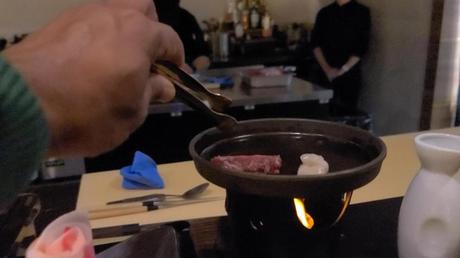This is this midlife adventurer’s review of Jumi Gozen Bar’s Gozen meal. The restaurant-bar is located in Toronto, Canada.
The Gozen-Style Meal
Until now, I have had the typical Japanese meals – sushi, sashimi, teppanyaki, bento, ramen etc. – as well as omakase and kaiseki. But when I read about Jumi’s Gozen meal, I was at a loss. It sounded more like Kaiseki though not served/sold as kaiseki. I kept researching but never found that unique difference between kaiseki and gozen.
Jumi’s website itself explains the concept of Gozen:
“Gozen is a traditional Japanese meal set consisting of a main dish, rice, soup, tsukudani (pickles) and multiple side dishes all beautifully served together on a single tray.
“Known as the “Emperor’s Meal”, Gozen was historically served to high-class emperors and nobles of the Japanese empire”.
Jumi Gozen Bar’s Gozen Meal
The restaurant serves its dinner in two time allotments – 5.30 pm and 7.30 pm and I had booked the second slot.
Once we arrived, we were shown our seats. It is a small, minimalistic restaurant with 10 seats, all set around the countertop behind which the chefs worked. I love the simplistic interior design of some of the Japanese and Korean restaurants. They use black and red to maximum effect.
I was given a small wooden box with two holes – the shallower one had a white, peppermint-like object and the deeper one empty. And I knew what the white object was: a compressed “coin” towel. Then the waitress poured some water into the empty hole.
 The Warm Wet “Coin” Towel at Jumi Gozen BAr
The Warm Wet “Coin” Towel at Jumi Gozen BArI put the white coin into it and immediately expanded by absorbing the water so that it became a warm towel.
The waitress asked whether I would like cold water, hot water or green tea and I went for green tea.
I also ordered Hakuru Kara Kara Honjozo sake. It is a dry sake but I found the taste strong with a tinge of acidity.
Then the chef introduced himself and my first question was: what is the difference between kaiseki and gozen?
So, it turns out, kaiseki is also a set menu but it is served course after course whereas all the dishes of gozen are served in a single tray, in one shot.
And then we got that tray of Gozen meal.
 Jumi Gozen Bar’s Gozen Meal Dishes
Jumi Gozen Bar’s Gozen Meal DishesHere are the dishes
- Half of a boiled egg, Maple teriyaki duck breast skewer, Sujiko (in the small closed container)
- In the second row the single dish contained grilled black cod.
- Then came the kono-shiro Tawara sushi (which I have gathered is a fish species unique to Japan), Japanese taro, and pumpkin mochi in a slightly sweet sauce.
- The last row was dedicated so sashimi – king salmon and amber jack.
- There was clam soup to wash everything down.
- Then there was the main dish – Australian wagyu beef for grilling. The chef said that once we are ready for the meat they will bring the grill. There was also carrots, sweet peppers, and mushroom slices for the grilling.
- As an accompaniment, there was koshihikari rice with seasonal mushrooms.
 Jumi Gozen Bar’s Gozen Meal Dishes
Jumi Gozen Bar’s Gozen Meal DishesThis is my time having sujiko, which is salmon/trout roe but fished out much earlier and therefore more fragile. The chef said it was marinated in miso and, as he alerted me, a little stronger in taste that can remain on the palette for a while. The sashimi pieces almost melted in the mouth.
 Koshihikari Rice with Seasonal Mushrooms – Jumi Gozen Bar’s Gozen Meal
Koshihikari Rice with Seasonal Mushrooms – Jumi Gozen Bar’s Gozen MealThe addition of the taro and the pumpkin mochi in a slightly sweet sauce to the meal added more contrast to the tastes (even though the dishes were mostly umami flavoured and did not contain any spicy ingredients).
In between I also tasted the soup.
When I was done with the tray, I told the chef I am ready for the hot skillet.
 The Australian Wagyu Beef – Gozen Meal at Jumi’s Gozen Bar
The Australian Wagyu Beef – Gozen Meal at Jumi’s Gozen BarThe beef was excellent. I always prefer meat a little bit more on the cooked side and this was succulent and soft.
And then we had the dessert of ice cream with chestnut financier. The cold ice cream and the warm financier made a perfect blend.
 Chestnut Financier with Ice Cream
Chestnut Financier with Ice CreamIn between the waitress kept filling up my green teacup.
Final Comments
Most of the ingredients, from some of the fish sorties to the beef, were imported and fresh.
The restaurant also has a good selection of sake, wine, beer (interestingly, some are Japanese beers brewed in Europe) and Japanese whiskeys.
